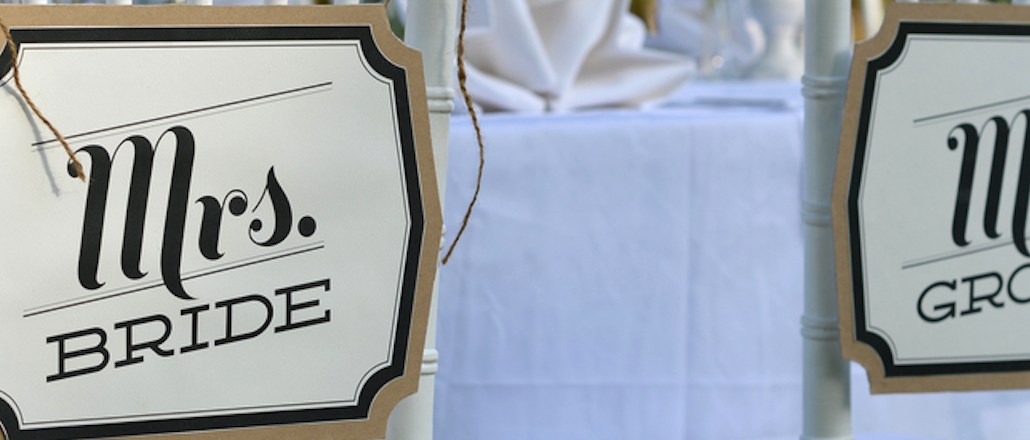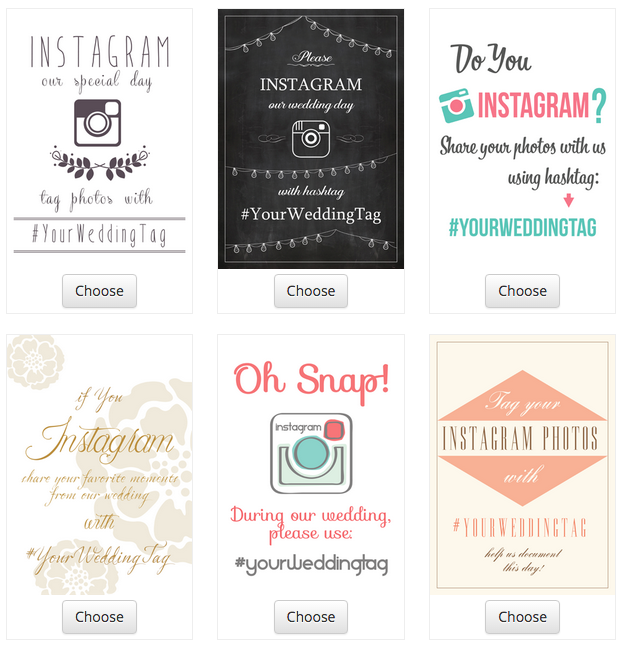Wedding hashtags are bringing in new business for the billion-dollar industry

For social media-savvy couples, the wedding hashtag is one of the few parts of getting married that doesn’t cost the bride and groom anything. That, however, hasn’t stopped entrepreneurial types from trying to capitalize on the trend.
According to wedding-planning site TheKnot.com’s site director Anja Winikka, wedding hashtags got their start in 2012. These cutesy slogans, both of the straightforward (#SaraLovesBen) and cheeky (#HappilyEverEaton) variety, sort photos into one Instagram scroll from the guest perspective, creating a spontaneous and personal digital album. Consider it the modernized version of the disposable cameras left on reception dinner tables.
Since 2012, the hashtag trend has boomed. The Knot conducted a survey with Mashable that examined the state of digital wedding trends in the $55 billion industry. They found that in 2014, 55 percent of couples said they would use a personal wedding hashtag. In 2012, at the time of the last survey, only 9 percent of engaged couples surveyed had said that they planned to do so. This year, the percentage is sure to have soared higher.
“It’s really no wonder it’s gotten so huge,” said Winikka. “Everything you’re doing in your life is captured on Instagram already, and on your wedding day, you want to be able to call attention particularly to those little moments. What better way to do that than to create a custom hashtag?”
Winikka said that today, wedding planners and photographers who show off their Instagram talents and can promise to brainstorm the perfect hashtag offer an edge in booking new clients. Other planning sites, like the WeddingWire, have adopted a hashtag generator as a marketing tool to get new members to sign up. WeddingWire editor Kim Forrest said the tool has produced 26 million potential hashtags since launching in March.
Now that the trend is becoming more ubiquitous, couples also have to get creative to ensure that another wedding hasn’t already taken their hashtag of choice and populated their feed on Instagram.
The challenge inspired the creation of TheWeddingHashtag.com in May by Kansas City journalist Andrew McKeegan and his co-founder Matt Spitsen. The goal is to brainstorm hashtags for couples who need some creative help. To “order” a hashtag, the engaged send an email to the company with a few pieces of information — both names, wedding location and venue, date, nicknames and fun facts. A return email will pop up from the hashtag creators within 48 hours with a list of five or six potentials. Since launch, McKeegan said they’ve received about 100 requests.
The hashtags are free for couples to review and use, as McKeegan said. (“Couples getting married already have enough to pay for,” he said.) McKeegan and his co-founder are hoping to make money by, among other things, selling hashtag cards — decorative signs reminding people to use the tag.
For businesses based around the wedding hashtag, the money isn’t in dreaming up the catchy phrase but rather in everything the bride and groom can do with it afterward. Companies like Wedding Hashtag Wall and Eversnap will create and print hashtag cards in different styles and colors and produce a live stream of tagged photos to display in real time, during the wedding. Eversnap charges $399 for its package of services.

WeddingWire’s Forrest said that when she got married five years ago, wedding hashtags were nonexistent. Now, there are wedding day social media coordinators. She expects the digital trend to spread to other platforms, like Snapchat and Periscope, given photo and video live streams are a growing trend for weddings and receptions. And Forrest believes that the wedding hashtag’s popularity as a way to aggregate a personal Instagram wedding feed won’t be fading out anytime soon.
“It’s a great way for people to follow along and for couples to catch everything from the guests’ perspective,” said Forrest. “We’ll certainly continue to see businesses pop up around this new technology.”
Image courtesy of Shutterstock.
More in Marketing

Starbucks hires first-of-its-kind marketing role heading up fashion and beauty collabs
Neiv Toledano has joined Starbucks as its senior marketing manager of fashion and beauty.

TikTok Shop offers incentives to new sellers, as U.S. uncertainty is finally over
TikTok is jump-starting its e-commerce ambitions in the U.S., now an agreement on the U.S. deal has finally been signed.

How the MAHA movement influenced food and beverage brands in 2025
The MAHA movement has come to stand for different things in different people’s eyes, depending on which initiatives they most closely follow.





